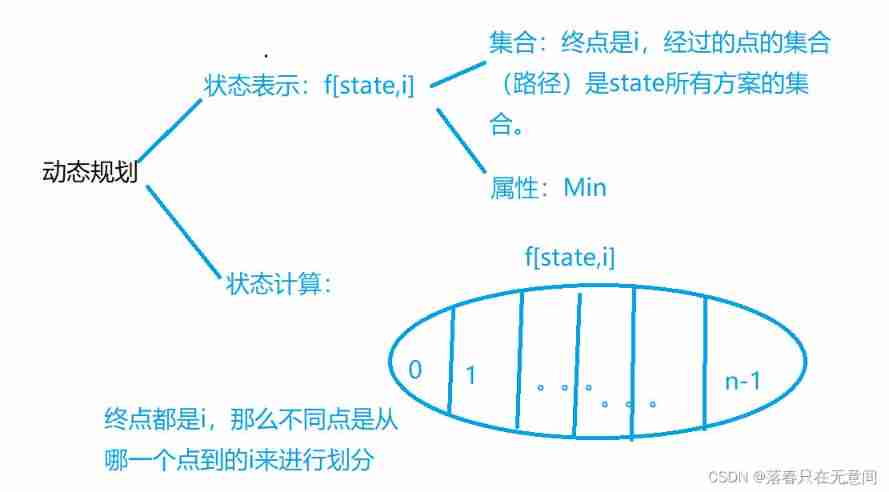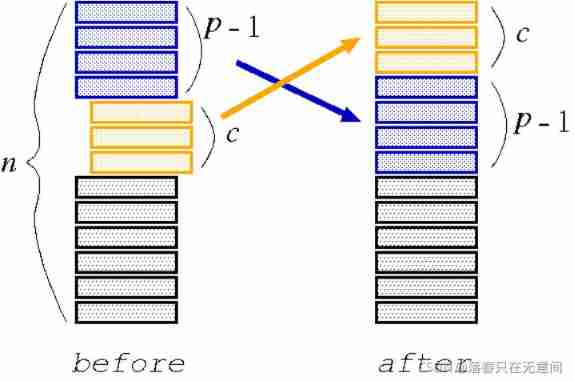当前位置:网站首页>The connection and solution between the shortest Hamilton path and the traveling salesman problem
The connection and solution between the shortest Hamilton path and the traveling salesman problem
2022-07-05 05:41:00 【Falling spring is only inadvertently】
The shortest Hamilton Path and traveling salesman problem
Preface
I found that many blogs either post code directly , Or it's right dp Explain the formula , It makes people feel speechless without saying why they got this formula , That might be why c standing
The shortest Hamilton route
Title Transfer door
The title means from 0 From point to n-1 The shortest point Hamilton route , We analyze it from the perspective of set 
So what are the conditions for this transition
- In the current path state ,i The corresponding position needs to be 1, That is, the end point of the starting point needs to appear on the path .
- For intermediate nodes k for , Each point can only appear once , So let's get rid of i Then the set of corresponding paths needs to have nodes k.
If the above conditions are met, there can be a transfer formula :
d p [ i ] [ j ] = m i n ( d p [ i ] [ j ] , d p [ i − ( 1 < < j ) ] [ k ] + w [ k ] [ j ] dp[i][j] = min(dp[i][j],dp[i-(1<<j)][k] + w[k][j] dp[i][j]=min(dp[i][j],dp[i−(1<<j)][k]+w[k][j]
Let's take the outer cycle as the last , That is to say state State transition means that all points pass through once , The second cycle is n-1 That is, the end of the question , We're enumerating k That is, we are considering which point is better to arrive at the end , If we choose a point , Then there will be the same sub problem at this point .
Code :
#include<iostream>
#include<stdio.h>
#include<cstring>
using namespace std;
const int N = 20 ,M = 1<<20;
int f[M][N] ,weight[N][N];
int n;
int main(){
scanf("%d",&n);
for(int i=0;i<n;++i)
for(int j = 0;j<n;++j)
scanf("%d",&weight[i][j]);
memset(f,0x3f,sizeof f);
f[1][0] = 0;
for(int i=0;i< 1<<n;++i)
for(int j=0;j<n;++j)if(i>>j &1) // There are j
for(int k = 0;k<n;++k)if(i-(1<<j)>>k & 1 ) // There are k, But there is no j
f[i][j] = min(f[i][j],f[i-(1<<j)][k] + weight[k][j]);//i-(1<<j) Already in if Prove that the location exists
printf("%d\n",f[(1<<n)-1][n-1]);
return 0;
}
Travel agent problem
Why should I compare the problem of travel agents with Hamilton The paths are written together , The traveling salesman problem is abstractly a starting point arbitrary and the end point is its own Hamilton route .
Let's think back to Hamilton In the path , d p [ i ] [ j ] dp[i][j] dp[i][j] What arrays mean is : from 0 Appear to the end j, And each point only goes once i Shortest path , Then we are finishing the calculation Hamilton After path , We just need to add a line from the end to 0 The path of , Then we can form this starting point arbitrary traveling salesman problem .
So here comes the question , Someone may ask why it is connected to 0 It can't be anything else ,
First of all, we know that if we choose arbitrarily at the starting point, then every point can go once , Then the end is definitely not this point , Then we can specify that the last point is 0( Then add 0 The distance to the starting point ) Because the first point of the starting point is arbitrary , Finally, we get a minimum value in any possibility .
So let's turn over this idea , We can make the point pointing to the starting point arbitrary , Then the first point pointed by the starting point will not be arbitrary ( Recall what probability theory learned ), Therefore, we can set the first point of our starting point 0, Then we can transform this part into Hamilton Path . Here's the code
Code :
#include <iostream>
#include <algorithm>
#include <cstring>
using namespace std;
const int N = 16, M = 1 << N, INF = 0x3f3f3f3f;
int n, m, g[N][N];
int f[M][N] ;
int main() {
cin >> n >> m;
memset(g, 0x3f, sizeof g );
memset(f, 0x3f, sizeof f);
while (m--) {
int a, b, c;
cin >> a >> b >> c;
g[a][b] = c;
}
for (int i = 0 ; i < n ; ++i)
g[i][i] = 0;
f[1][0] = 0;
for (int i = 0 ; i < 1 << n ; ++i)
for (int j = 0 ; j < n ; ++j)
if (i >> j & 1) {
for (int k = 0 ; k < n ; ++k)
if ((i - (1 << j)) >> k & 1)
f[i][j] = min(f[i][j], f[i - (1 << j)][k] + g[k][j]);
}
int res = INF;
for (int i = 0 ; i < n ; ++i)
res = min(res, f[(1 << n) - 1][i] + g[i][0]);
if (res == INF)
cout << -1 << endl;
else
cout << res << endl;
return 0;
}
边栏推荐
- Annotation and reflection
- Fried chicken nuggets and fifa22
- Cluster script of data warehouse project
- 全国中职网络安全B模块之国赛题远程代码执行渗透测试 //PHPstudy的后门漏洞分析
- Talking about JVM (frequent interview)
- 剑指 Offer 05. 替换空格
- Over fitting and regularization
- Personal developed penetration testing tool Satania v1.2 update
- 软件测试 -- 0 序
- 挂起等待锁 vs 自旋锁(两者的使用场合)
猜你喜欢

shared_ Repeated release heap object of PTR hidden danger

Sword finger offer 05 Replace spaces

Solution to game 10 of the personal field

读者写者模型

Sword finger offer 04 Search in two-dimensional array
![[cloud native] record of feign custom configuration of microservices](/img/39/05cf7673155954c90e75a8a2eecd96.jpg)
[cloud native] record of feign custom configuration of microservices

智慧工地“水电能耗在线监测系统”

剑指 Offer 06.从头到尾打印链表

Introduction and experience of wazuh open source host security solution

Chapter 6 data flow modeling - after class exercises
随机推荐
Animation scoring data analysis and visualization and it industry recruitment data analysis and visualization
Haut OJ 1401: praise energy
[cloud native] record of feign custom configuration of microservices
读者写者模型
常见的最优化方法
ALU逻辑运算单元
Personal developed penetration testing tool Satania v1.2 update
Fried chicken nuggets and fifa22
Reader writer model
剑指 Offer 06.从头到尾打印链表
剑指 Offer 09. 用两个栈实现队列
浅谈JVM(面试常考)
Web APIs DOM node
Sword finger offer 09 Implementing queues with two stacks
After setting up the database and website When you open the app for testing, it shows that the server is being maintained
[jailhouse article] look mum, no VM exits
Convolution neural network -- convolution layer
object serialization
R语言【数据集的导入导出】
每日一题-搜索二维矩阵ps二维数组的查找